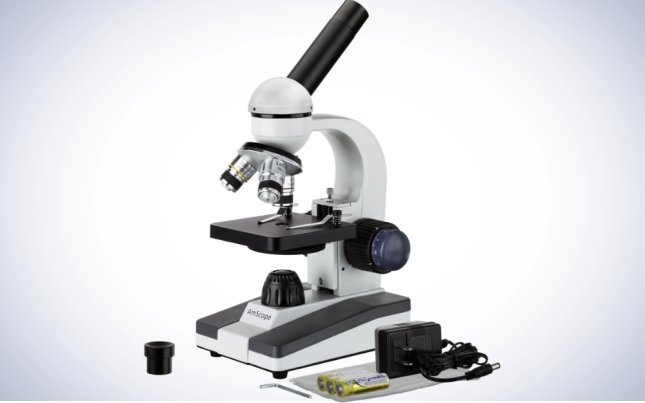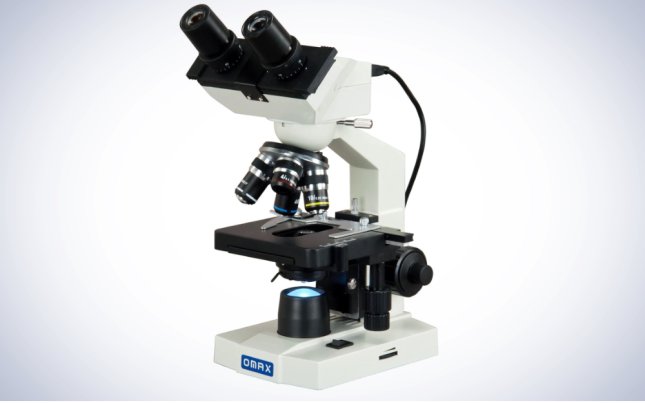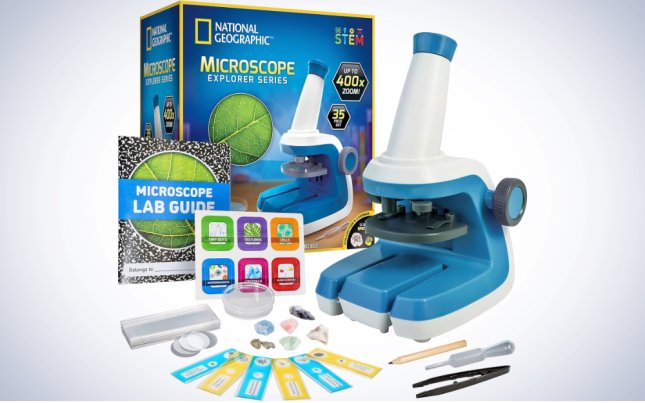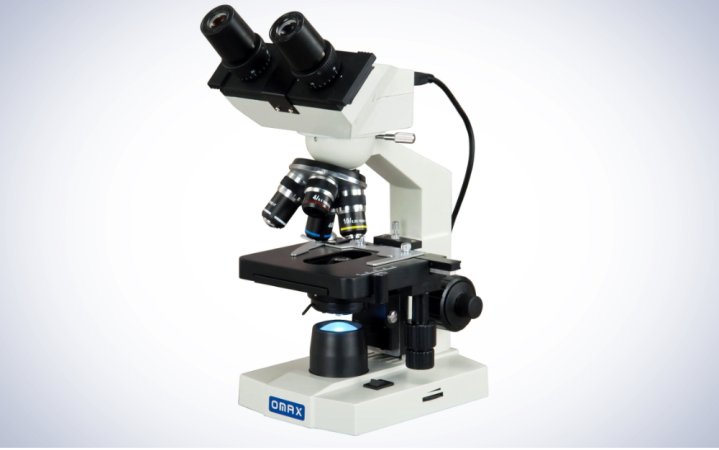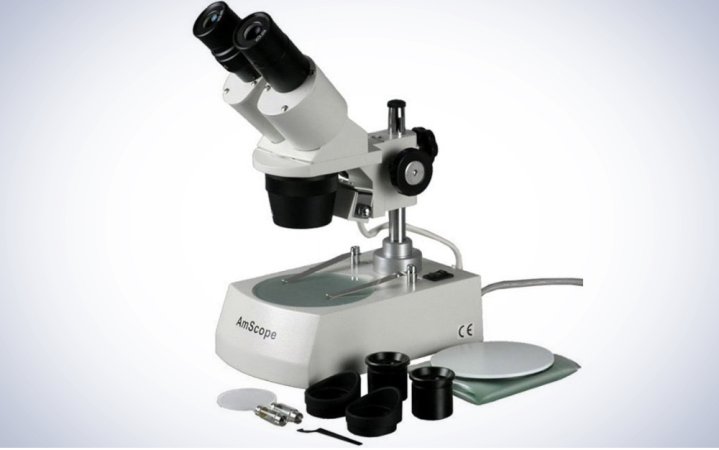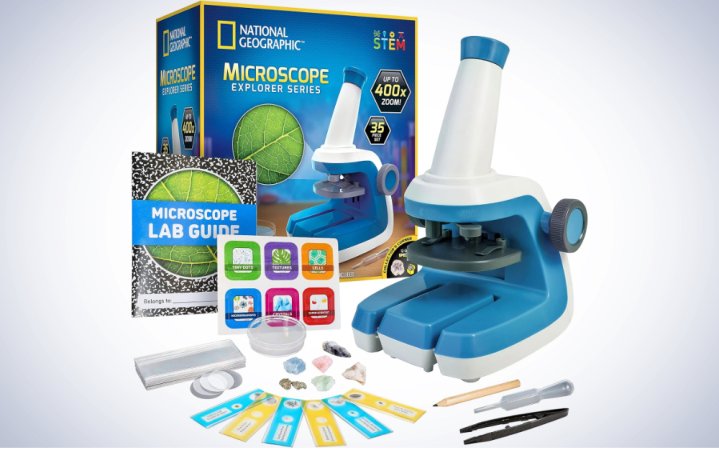We may earn revenue from the products available on this page and participate in affiliate programs. Learn more ›

There’s a wide world full of shapes, colors, and things for the inquisitive to observe, but only with microscopes for students can the scientifically inclined investigate the world within the world—the world of the tiny. From the fine scratches on the top of a worn penny to the cilia of microbial life, a lot is going on that the naked eye cannot see. But what constitutes a great microscope is not always clear. Depending on the level of the student, they may need almost literal hand-holding through the operation of the scope, with interesting slides pre-prepared. Situations may call for less intense magnification and simpler devices that even young students can use if guided properly. In other scenarios, some microscopes connect with high-quality displays, letting a group work together, seeing and documenting what they find simultaneously. No matter your needs, these are the best microscopes for students, and one will likely fit your needs.
- Best overall: AmScope M150C-I
- Best for groups: OMAX-MD82ES10
- Best for active students: AmScope Student Forward Binocular Stereo Microscope
- Best splurge: Accu-Scope EXM-150-MS-DF
- Best budget: National Geographic STEM Kit
How we selected the best microscopes for students
It can be hard to believe that your friendly neighborhood article writer came from anywhere but a cramped library, surrounded by books and manuscripts. This one, however, came from cramped (and sometimes quite spacious) laboratories. One period of several months spent counting pollen for hours and hours a day—when, at 22 or so, I was hardly beyond being a student myself—stands out particularly in my mind as a period of learning and understanding the intricacies of microscope usage.
Of course, the microscopes presented below will be good for students, both young and old, with various capabilities depending on the age group. While no microscope is indestructible, they’re universally quite fragile at the lens, we are aiming for microscopes that can withstand (or safeguard against) beginner follies and common pitfalls. Two other features that give a big boost to a microscope’s suitability for students are easy ways to view and share what’s being seen, as well as supplied activities and guidance.
The best microscopes for students: Reviews & Recommendations
The following microscopes were all picked to satisfy your student at home or, as the case may be, in a group at your school, club, or other location. Check out each one to compare and contrast it to your needs. Also, while there will definitely be some overlap with the microscopes on this list, you should check out our listing of the best microscopes for kids. This goes doubly so if you feel that the microscopes and activities listed here are too difficult or challenging for the student you have in mind.
Best overall: AmScope M150C-I
Pros
- Classic style used in real labs and universities
- Wide magnification range good for most activities
- Teaches real microscope skills
- Affordable for most
Cons
- No included investigation kit
- Not ideal for youngest learners
Specs
- Style: Compound
- Magnification: 40X – 1000X
- Included activities: No
The AmScope M150C-I resembles many other microscopes but comes in at $100, within a serious student’s budget, and affordable enough multiples can be purchased for a group of learners. This microscope will teach real responsibility with a microscope, including proper handling, as well as give students a chance to see the smallest parts of the world properly. It uses a proper compound style, has an easily graspable fine coarse control, and an adjustable light source that can be powered either via batteries or an outlet.
This microscope has an incredible range of magnifications that you can use it at, as well. The world at 40X and 1000X, the two extremes this microscope has to offer, will appear almost completely different and will allow for different activities. At a low magnification, look at the exterior of a bug or plant “skins” up close. Then, at 1000X, take a look at the cells themselves. With all of these factors combined, you should expect your students to be able to learn a wide variety of lessons with this scope, making it a best value.
What gives us pause about this microscope is that it does not come with activities and may not be suitable for fast-moving and excitable youngsters. If you are the creative type and have equally curious and motivated students, these issues can be circumvented, however. Setting up scenes for young students to look at—without adjusting the scope themselves—can certainly help. Consider looking at award-winning microscope imagery and other outstanding microscope shots to spur creative impulses.
Best for groups: OMAX-MD82ES10
Pros
- Built-in 1.3MP USB camera
- Easy to connect software
- Very solid slide grip
- High longevity in use cases
Cons
- Optional oil immersion capabilities are complex
Specs
- Style: Compound
- Magnification: 40X – 2000X
- Included activities: No
The OMAX-MD82ES10 is a bi-focal compound microscope with a secondary viewing pattern—accessible through the 1.3MP camera that exports imagery through USB. This gives large groups of students of all capabilities a chance to simultaneously look at the same field of view. That can mean trusted students taking turns finding things in a microscope and being able to share what they see with each other in real-time or a teacher-led activity that lets students of all capabilities share in on the excitement. Furthermore, individual students can copy and save imagery and videos on the secondary view, allowing them to share their findings with the world.
Another point about this microscope is its build and construction. Take its slide-holding mechanism, with squared-off edges that grip and secure slides snuggly. Compared to less form-fitting mechanisms, there will be considerably fewer fears of slides popping up and tapping the lens, as well as less frustration when changing slides. You’ll also appreciate dual-sided fine focusing, maximizing comfort for right- and left-handed users.
We do think that for many students (and even teachers), the thought of using oil immersion microscopy—a very advanced technique and a capability included on this scope—may be rightfully intimidating. The good news is that getting quality shots does not require its usage, and the capability is there for you when (and if) you eventually want to try it.
Best for active students: AmScope Student Forward Binocular Stereo Microscope
Pros
- Stereo microscope usable by younger students
- Higher magnification than many stereo scopes
- Easy-to-use design
Cons
- Cannot see cells, etc.
Specs
- Style: Stereo
- Magnification: 10X – 60X
- Included activities: No
When we think of microscopes, we often think of compound microscopes, which can be problematic for students. Their lenses are very close to the subject, so small mistakes can ruin them easily. It can also be very difficult to find interesting things with them.
Enter the stereo microscope. These microscopes are designed for looking up close and seeing new details on full objects. Typically only getting about 50X magnification, max, these microscopes are great for revealing the finer details of rocks, bugs, and more. This AmScope student stereo microscope can get up to 60X zoom, quite better than others. It also has a lengthy distance from subject to lens, meaning an excited or shaky student is unlikely to damage the lens while putting something into frame.
We highly recommend a microscope like this for examining specimens from nature hikes, studying plants, and more biological research. The binocular eyepiece setup will also allow students to lean into the microscope more—holding your head properly at a microscope is more difficult than you might expect—without hiring their faces.
Best splurge: Accu-Scope EXM-150-MS-DF
Pros
- Student-proof design protects lenses
- Darkfield option increases visibility
- Cordless LED lighting
Cons
- Expensive
Specs
- Style: Compound
- Magnification: Up to 400X
- Included activities: No
One of the biggest fears surrounding finding the best microscopes for students is the possibility of them messing up the lenses. It happens to fully trained adults in absent-minded moments of haphazardly switching from far to near focus, so imagine the possibilities for error in our youngest scientists!
This Accu-Scope microscope helps prevent this issue by including a pre-set focus stop to help students avoid hitting the lens. Of course, it won’t completely prevent the problem, and students should still be properly trained in how to increase focus—both for the sake of this scope and potential future ones they encounter—but the added safety barrier certainly helps.
Another feature that makes this our premium pick (its main downside is that, at $400, it is expensive) is the darkfield switch. This method of microscope usage greatly increases contrast on the edges of cells and other objects, making it easier to see boundaries.
Best budget: National Geographic STEM Kit
Pros
- Has a great included kit
- Very affordable
- Entertaining presentation
Cons
- Cheap construction
Specs
- Style: Compound
- Magnification: 40X – 400X
- Included activities: Yes
Not all students are ready for an intense simulation of the laboratory. Additionally, not all students will dedicate serious time to the art of using the scope. For the science-interested but not dedicated, this kit is what you want. It’s the right price for a weekend or even a fun week. If your student continues with it, that’s great. If they don’t, it’s no harm, no foul. You know where your student lies on this spectrum.
It’s got a great kit with included activities and a fun, lighthearted guide to go with it. The construction of the microscope is similarly simple and non-intimidating. It’s brightly colored, soft, and forgoes a lot of the complexities of other scopes on the list. While its plastic construction won’t exactly give it the longevity to make it a hand-me-down, it will be easy for young people to use, even heavily, without fears of trouble. This is a microscope that young (but still responsible) individuals can use and make their own without excessive family worry over damaging expensive lenses. In other words, it is perfect as a gift for the budding scientist near you.
What to consider before buying microscopes for students
Microscopes are complex. There are no ifs, ands, or buts about it. Here’s a guide on what you should expect and how to choose a reasonable microscope for students:
Age suitability
In many ways, this comes at your discretion before buying a microscope. Not all students (or even parents) have the patience to use a highly detailed microscope with the care it requires. Finding interesting things, even in pond water at 400X+ zoom, takes patience and a careful hand.
Throughout the above, we’ve attempted to give you a glimpse at what you and your student child (or student group, should you be a teacher) might be able to accomplish with a given microscope. If the activities supplied seem outside the scope of what the student or student group can accomplish on a fundamental level, that microscope can be put in your “pass” pile.
Magnification level
The first thing to know about microscope magnification is that a higher magnification level is not always better. This goes doubly for students who—if given proper guidance—can find excitement at all magnification levels. Avoid the temptation to summarize microscopes as “cell viewing devices” only. A student envisioning a world of gladiatorial amoeba battles will become instantly disappointed with anything less.
Here is what to expect at various microscope levels, as well as target tasks that you can expect to accomplish reasonably:
Under 50X, we will begin to see things just beyond the border of what the eye can normally see. Here, your students can understand the surface of normal objects better. Great investigations here include looking at printed text, looking at the veins and stomata of a leaf up close, and seeing insects clearly up close.
By 100X, individual cells and pollen can be seen, though it will definitely feel like a “bird’s eye view” of sorts. Here, you can observe how many cells are in a small area of one pond’s water to another. Do you expect there to be a higher density of cells observable in a spot of pond water or tap water left out overnight? Can you find cells in your saliva? Onion cells look particularly good at this level.
If you get to 400X, you can observe cells up close and even see their insides. What structures can you observe, and how can they move? This is the stage where you can see amoeba, though you should be warned that observed cells will likely be dead or die quickly after being observed in a slide under the heat of a microscope’s lamp.
Of course, you can get magnifications beyond these, but these three levels are fairly standard for student microscopes. Remember, there is no best magnification level; there are just different magnification levels that are best for different jobs. For example, you wouldn’t want the highest resolution microscope, which can see atoms, for looking at cells.
Microscope types and control
One of the first choices in your microscope-picking journey will be the type of microscope. There are many types of professionally used microscopes, but for the purposes of student microscopes, you can broadly separate them into two categories: stereo microscopes and compound microscopes.
Stereo microscopes are an oft-overlooked style of microscope that are particularly suitable for students who lack refined motor skills and advanced self-control. They feature a single, wide lens that towers far above the subject. Control often involves moving the subject and adjusting the (usually below 50X) zoom level, with little else. Since the lens stays far above the subject, the odds of damaging it are much lower, and reasonably well-behaved students can be trusted with the microscope after adult preparation and instruction.
Compound microscopes and other microscopes with a dual-lens approach are invariably cooler to use. They allow for higher magnifications, after all. Unfortunately, they also require more complex skills to use, with the lens approaching the subject directly. Should the lens become scratched, it can become completely ruined. This can occur by switching a shorter lens to a longer lens without pulling away from the subject first or accidentally moving the quick-moving coarse adjustment when you meant to use the fine-adjustment knob or even panning. In schools—including college classrooms—it isn’t uncommon to make students pass an easy test to verify their knowledge of a compound microscope before using it.
Price
Given enough technology, your journey to peer into the world of microcosms can stretch to infinitesimally small places. Much the same, it seems that more and more microscope technologies can bring with them infinitely high prices.
For student microscopes, this isn’t the way.
While price points you’re willing to pay are personal, you should be able to find the best student microscope for your family or small group for the price of any other modern tech gadget, such as a 3D printer or laptop computer.
The prices of the student microscopes above vary widely. If you’re a family buying a microscope for an individual student, gauge their level of interest and stick-to-it-iveness and buy accordingly.
FAQs
A microscope for students can cost anywhere from about $60 to over $300 or $400. What you are willing to spend on this scale will largely depend on the number of students who will be using a single scope, your budgeting, and the overall purpose of the microscope.
Younger students tend to mostly use stereo microscopes, while older students will use a mixture of both stereo and compound microscopes. Neither is the “best” type of microscope—they have different applications—but stereo microscopes are usable with less experience and training than compound microscopes.
Ultimately, there is no designation for a “student microscope” in the world of scientists. With the exception of cheaper plastic models that are clearly made for children, you’re either using a microscope or you aren’t. Instead, we can think of a student microscope as one that more easily enables students to learn about the world and fits their needs more than others. In this way, multi-thousand-dollar microscopes with complex operations and niche uses are not student microscopes.
Final thoughts on the best microscopes for students
- Best overall: AmScope M150C-I
- Best for groups: OMAX-MD82ES10
- Best for active students: AmScope Student Forward Binocular Stereo Microscope
- Best splurge: Accu-Scope EXM-150-MS-DF
- Best budget: National Geographic STEM Kit
The preceding microscopes will be able to help your individual student or student group on their first explorations into the world of the microscopic (and potentially beyond). They are designed to encourage creativity and promote skill in the reasonable exercises that most entering scientists will need in a career in microscopy. Toss in one of the best telescopes for kids and you’ll have both ends of the curiosity spectrum covered, equipping your student with a broader understanding of the world(s)!
